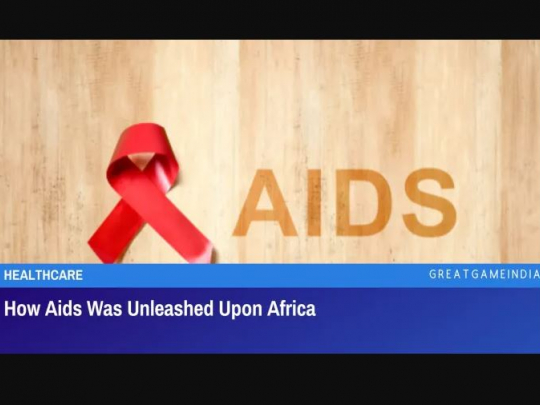How Aids Was Unleashed Upon Africa

Whatever the reality was about how Aids began, Africans were bearing the brunt of the burden. This is the story of how Aids was unleashed upon Africa. And should it come out that Aids was a Western medical blunder, then Western attitudes to assisting Africa and Asia in dealing with their spiraling epidemics must change.
Over the past few decades, interest in Aids and Africa has progressively increased, reports the Guardian. This has been due to circumstances such as then president of South Africa’s poorly timed remarks doubting whether HIV genuinely caused Aids, which have given Professor Peter Duesberg’s dormant theory undeserved publicity. Finally, major contributions have been provided by foreign contributors including the US and the UK.
The main theory that several people subscribe to was that the experimental oral polio vaccine (OPV), CHAT, which was administered to more than a million newborns, kids, and adults in the former Belgian territories of central Africa between 1957 and 1960, was what caused the Aids pandemic. It is now widely acknowledged that the simian immunodeficiency virus (SIV) of the common chimpanzee is the direct ancestor of HIV-1. Polio vaccines were first developed in the late 1950s using cells from monkey kidneys, but evidence would suggest that some batches of the CHAT vaccine—which was used to immunize children in Africa—were instead produced in chimpanzee cells.
The majority of Aids researchers, however, continue to support the theory that the virus was first acquired by a hunter or market woman who killed a chimpanzee for bushmeat and may have had wounded hands. When prompted, “Why now?” The response from “cut hunter” proponents is that it was likely decolonization, which led to urbanization and new sexual interactions, that allowed the acquired chimp virus to break free from its rural hearth, to propagate in an urban environment, and then to spread across Africa.
The cut-hunter notion appears plausible on the surface. On the other hand, the CHAT theory far better fits the existing data. For instance, it is now recognized that the CHAT researchers kept 400 chimpanzees in their camp in Lindi, near Stanleyville (now Kisangani), in the former Belgian Congo, between 1956 and 1958. Of them, over 300 were sacrificed after being used to test the polio vaccine. An increasing number of witnesses claim that the kidneys and blood were removed just before the sacrifice and then sent in flasks to Philadelphia and Belgium, where the CHAT vaccine used in Africa was produced.
Then there’s the startling links between CHAT immunization sites and the early onset of Aids. The same towns and villages where CHAT was supplied in the 1950s are where 64% of the first Aids cases seen in Africa (up to and including 1980) originated. These locations were all in the former Belgian territories of Congo, Rwanda, and Burundi. Furthermore, every single one of the first 46 HIV-positive blood samples from Africa originated within 140 miles of a CHAT vaccination site.
The CHAT hypothesis is reasonable, albeit it has not been verified, according to reviews of The River. However, researchers under the direction of Bette Korber estimated that the last common ancestor of all modern HIV-1 variants—which they dubbed “the Eve virus”—lived around 1931, give or take 10 to 20 years. Korber deemed the polio vaccination hypothesis to be “highly unlikely” given that this was before the CHAT trials started.
Numerous American journalists concluded that this theoretical data resolved the matter, which it most definitely did not. Gerry Myers, Korber’s mentor and former employer, would then argue against her stance at the Royal Society conference by pointing out that the new data is more consistent with the CHAT theory than the cut-hunter theory, and that Korber’s dating provides no information about the timing of the transmission of chimpanzee SIVs to humans.
Biologist Bill Hamilton, who for many years was a main proponent of the CHAT theory among scientists, was the one who first suggested the conference. He visited Kisangani to gather faeces samples from chimpanzees in order to determine whether any of them were SIV-infected. Kisangani was at the time in the thick of a civil war. Tragically, he got malaria and passed away soon after arriving in England.
Hamilton and others who think the CHAT hypothesis merits a fair hearinghad come under a barrage of unusual public and private insults, with claims that everyone who was involved in organizing the London meeting was opposed to science.
In fact, there are compelling reasons to continue the discourse that so many would like to silence. One benefit of understanding how a disease developed is that it typically leads to a greater understanding of how to treat, prevent, or mitigate it. Another point to consider is that the CHAT narrative has significant implications for future medical and scientific practice at a time when we may be ready to embark on additional well-intended, but perhaps more harmful, biomedical treatments. These include xenotransplantation (the transfer of animal organs into humans, together with any undiscovered viruses that may be present) and trials of live Aids vaccinations (which have the potential to recombine with existing HIV variants, to devastating effect).
In June 1981, a German missionary doctor, Margerete Bundschuh, encountered five women from Uganda’s border districts with rare bacterial illnesses of the groin and anus, as well as a guy whose penis had “half rotted off.” “We had the impressions – sex infection, three to six months of slow deterioration, then acute disease and death. At that time, there was no long stage of undetectable Aids,” she wrote afterwards. Bundschuh worked at Mugana hospital in northern Tanzania, on the smugglers’ path leading to Lake Victoria and Kasensero, which would see its first cases a few months later.
Locals in Tanzania dubbed the new ailment ‘Juliana,’ while Ugandans dubbed it ‘Slim.’ This element alone disproves Peter Duesberg’s arguments that the Aids epidemic in Africa is essentially a collection of ancient diseases to which Western doctors have given a new name.
So, how did HIV-1 get to the Uganda-Tanzania border? This coffee-growing region attracts a large number of Hutu migrant laborers from Burundi and Rwanda, therefore one of them could have been the carrier. However, there is another reason.
Hundreds of thousands of Tutsi refugees escaped ethnic strife in Rwanda in the early 1960s. 3,000 of them were transported to this location and encouraged to settle in 1962. They came from Butare and Nyanza, two of Rwanda’s four “territories” where the CHAT vaccination was delivered. Shortly after, a two-year-old boy from one of the settlement communities died of aggressive Kaposi’s sarcoma, which could have been an early instance of Aids.
Later, the same region was subjected to a series of upheavals. In 1978, Idi Amin’s army invaded northern Tanzania’s Kagera salient, and Julius Nyerere summoned 45,000 men to confront him. They diligently trained for the counter-invasion for three months.
Seven thousand troops from the 207th brigade slept on an open, grassy plain near Bugandika. Locals said that there had been numerous rapes and that “soldiers came and went from village houses. There were many divorces. Girls and mothers came here from far away for meat and beer.” Bugandika, at the foot of the smugglers’ road, is only nine kilometres from Mugana hospital.
It appears plausible that an individual who spent some time at that camp, whether a soldier or a female guest, was already infected with HIV, and that a seed was planted in a fertile setting, similar to what happened in homosexual bathhouses in America at the same period. The 207th traveled a different path north from Bugandika than the other Tanzanian brigades. It crossed into Uganda in Kyebe, the settlement of Joseph Ssebyoto-Lutaya, and then pushed north through Kyotera and Masaka to Kampala, where it occupied until Tanzania’s withdrawal in 1981. By 1987, a quarter of the women in Masaka and Kampala were HIV-positive, and Kyebe and Kyotera were well-known as Aids epicenters.
Uganda launched the first Aids Control Programme in Africa in 1987, and commenced a health education program that persists to this day, with posters, TV commercials, classes in schools and villages, and the famous radio show Straight Talk. The benefits are plain to observe. President Yoweri Museveni recently declared that national (adult) HIV prevalence had dropped from 30% in 1992 to less than 10% now.
Whatever the reality is about how Aids began, Africans were bearing the brunt of the burden. Africans accounted for around 15 million of the then 19 million people who had died worldwide. Aids would kill half of all 15-year-olds in Zimbabwe, Botswana, and South Africa. This was an extraordinary tragedy, and it required an unprecedented reaction.
For perspective into how bad the situation in Africa was at the time, when the Durban Aids Conference began, African doctors and scientists were stating Africa desperately needed:
- additional needles, syringes, gloves, gowns, and protective gear, so that the virus is not unnecessarily transferred to medical professionals or other patients.
- additional drugs to treat Aids symptoms.
- additional antiseptic solutions and IV infusions; more linen, bedding, and beds.
- more HIV test kits.
- additional funds for the training and support of doctors, nurses, and counselors.
- more condoms.
- greater health education with a stronger emphasis, especially for children, repeat twice.
These were the easy solutions that were effective and could save lives. Contrarily, very few people could afford anti-retroviral treatments, and the majority of African nations lacked the necessary health systems to distribute and oversee the medications.
If the oral polio vaccine theory were to be proven correct, a horrifyingly painful lesson would finally be learned. Numerous vaccines save lives. But before they are made available, new vaccines—including those for HIV—must undergo thorough and adequate testing. The same holds true for new genetic and medicinal procedures; they must be thoroughly examined, even if it costs more money and delays any possible advantages.
However, if CHAT/Aids were proven to be right, it would benefit no one if the original researchers, or the institutions or governments that financed them, were held legally liable. At its heart, the CHAT vaccination story was about trying to help people rather than killing them. CHAT, like previous polio vaccines, was first tested on the disabled, then on criminals. Finally, their colonial overlords ‘volunteered’ one million Africans for immunization.
Some vaccine manufacturers now portray this technique as a heroic endeavour to combat polio epidemics in Africa. This is mostly false. Polio was a Western plague in the 1950s, but by the age of five, 95% of Africans were naturally immune to the virus. Essentially, the vast majority of African CHAT vaccination recipients were utilized as guinea pigs to test the safety of a Western vaccine.
The Aids vaccine was developed against HIV-1 subtype B, also known as the Euro-American virus, which is rarely, if ever, detected in Africa. Ugandan researchers say they want to see if a vaccine against one subtype can protect against others, and they believe vaccine manufacturers have promised a vaccine against subtypes A and D (which was common in Uganda) within two or three years. However, evidence from chimp trials indicated that a vaccine designed to protect against one subtype did not defend against others. So, were the mistakes of the past repeating themselves?
If Aids was a Western medical blunder, then Western attitudes to assisting Africa and Asia in dealing with their spiraling epidemics must change. At the absolute least, this would entail Western governments (particularly those of the United States and Belgium) assuming responsibility for the devastation created by past paternalism and blunders.
- Source : GreatGameIndia


















